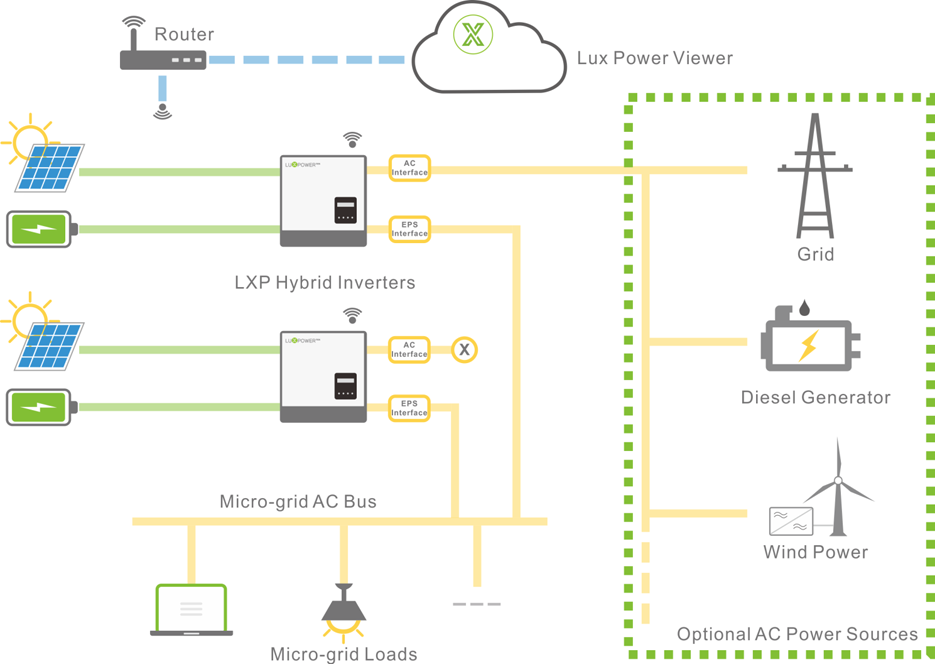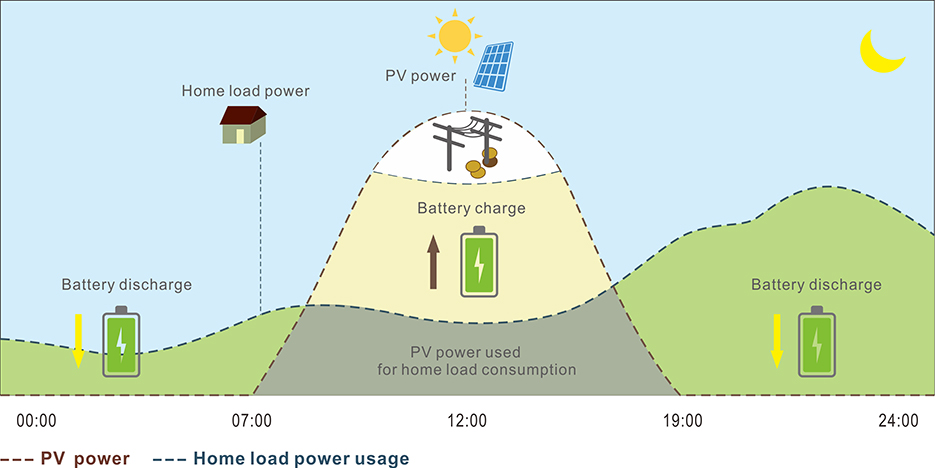Solar technology is changing the way we use energy in various industries as well as in our homes. The hybrid inverter is one of three cores for solar power systems. At the same time, there are a variety of solar inverters on the market, such as the Battery Inverter, the Off Grid Solar Inverter, etc.
We will now focus on one of them: the solar hybrid inverter. As the name suggests, a hybrid solar inverter is a combination of two or more systems. The inverter is a key component of solar power systems. If you don’t know much about hybrid inverters, we’ll explain the issues related to hybrid inverters for you.

What is a solar hybrid inverter?
A hybrid inverter is a machine that converts DC generated by a solar panel into AC for household appliances. A hybrid solar inverter stores excess solar energy in a storage system that can be used for it, much like a grid-tied.
The stored AC power is then converted from the batteries to power the load when needed. Many hybrid inverters are able to operate without batteries and can export excess solar energy to the grid. A hybrid inverter can be used in conjunction with a solar panel system. That’s because it can use as both a power inverter for solar panels and solar cells.
Hybrid Inverter Operation Modes


The majority of hybrid inverters can operate in four modes.
Grid-connected mode: functions similarly to a regular solar inverter (no batteries). Its main drawback is that it does not have grid isolation, which means it cannot power your home in a power outage.
Hybrid mode: To increase self-sufficiency, you can store excess solar energy and use it at night.
Standby mode: Functions like a regular solar inverter when connected to the grid and automatically switches to standby power mode in the event of a grid outage. This inverter is able to power your home, charge your batteries, and supply surplus power to the grid.
Off-grid mode: This inverter functions much like an off-grid one. It uses excess solar power to charge batteries and to power loads, but does not connect to the grid.
Luxpowertek
Paralleling LXP inverters (single phase inverters) to build a three phase system for either hybrid or AC coupled energy storage applications. Paralleling LXP inverters in one phase to extend the single phase system capacity for either hybrid or AC coupled energy storage applications. Intelligent paralleling algorithms enable multiple configurable working modes under on-grid, off-grid, or microgrid applications.
Only a few hybrid inverters are designed for off-grid solar power systems and can start and run backup power when needed. Hybrid inverters with off-grid mode include the LXP Hybrid 3-6k and the LXP Hybrid 4-6k HB.
Benefits of hybrid inverters
There are many advantages of solar hybrid inverters which we need to consider when choosing a solution.
Cost savings
Let’s say you want to add a backup battery system to your solar PV system. Not only will you need to buy the battery bank, but also a new inverter and possibly a battery charger controller. The cost price of this whole package is much greater than purchasing a hybrid inverter. Hybrid inverter systems are now more cost-effective and include performance monitoring, charge control, bi-directional AC DC inverter functionality, and charge control.
A hybrid inverter/battery will be more expensive upfront than installing a grid-tied solution. If you are frequently experiencing power outages, or if you want to use the batteries to arbitrate tariffs, this additional cost is worth it.
Smart
Not all inverter systems can continue to provide power even when there is no power. So to continue to have power during a power outage, pairing the batteries with a hybrid inverter is a great solution. A hybrid inverter also has a built-in charge controller that detects when best to supply power to the batteries from the grid (or solar panels).
The hybrid inverter sends system performance data to a company-branded portal on the cloud. You can log in to the app and see how your system performs. The hybrid inverter can also be automatically set to standby when there is sufficient power. These ensure that you make the most of the energy generated by the solar panels, even when you’re not on site.
DC coupling options
Hybrid inverters have higher efficiency. Conversion losses can cause power loss when you need to convert AC to DC, or back to DC again. Many hybrid solar inverters can be DC-coupled. This means that DC power is taken from the solar panel and fed directly into the battery without having to convert it to AC and back in the process.
Battery storage devices
A hybrid inverter has a number of great benefits. It combines the functions of two different devices into one. This can mean a more straightforward installation process for your solar installation program.
You can save money by purchasing a hybrid inverter from the beginning, regardless of how much each component costs. However, if you don’t plan to add battery storage to your system, compare a hybrid solution to a traditional grid-tied solar inverter, as their upfront costs may be lower.
Disadvantages of hybrid inverters
Hybrid Inverters may not be the best solution for all solar panel systems. Here are some drawbacks.
Adding extra costs
It is easy to install an AC-coupled battery and its inverter if you have an existing solar panel system. Your solar panel system already includes its grid-tied Inverter. However, it will be more costly to swap that part for a hybrid solution.
Backup power limitations
Some hybrid inverters cannot use the power from solar panels when your home’s power grid fails. As a result, they can be affected by weather or climate change. The battery life is also shorter due to the fact that you must connect the solar panels to the batteries.
And some hybrid inverters allow you to route solar and battery power to a smaller baseload during a grid outage. Some inverters allow you to have full power flow from your batteries to the backpack even if there is no power. But no matter what type of system you choose, it’s essential to understand the system’s capabilities so that you fully understand its limitations when you expect to take full advantage of high-capacity battery output.
Weather Rating
While most hybrid inverters have an IP65 weather rating, which means they can be mounted on the outside of your home, not all models are. That’s why it’s critical to ask before you buy.
What is the difference between a hybrid inverter and a regular inverter?


An inverter’s primary function is to convert direct current (DC), to alternating current. It takes energy from the energy source (DC) to do this. Ordinary inverters use fuel as an energy source.
On the other hand, a hybrid inverter integrates that DC power source. In the case of the hybrid solar inverter, one of the sources remains solar energy. It then turns the DC power into AC power – the kind of power you use in your home. You can’t use DC power directly in your home because it can be deadly.
How does a hybrid solar inverter work?
Understanding how a hybrid solar inverter works dramatically helps you to choose a hybrid inverter better. It is an important part of a solar energy system.
- A solar inverter converts the energy produced by the photovoltaic panels into a form that can use in your home. Photovoltaic panels capture the sunlight and convert it into electricity. An electric field pulls these free electrons in the desired direction. This is how the inverter generates electricity. However, this electricity is direct current.
- Now, the inverter’s job is to convert this electrical energy into a usable form. It uses insulated gate bipolar transistors (IGBTs), which are solid-state devices, meaning that they are solid-state electronic tools that allow current to pass through them. In addition, they are durable and do not consume too much power.
- The H-bridge converts DC power to AC power. It then sends this power to a transformer, specifically a step-up transformer. The transformer can be used as a step-up or step-down transformer. It depends on the direction of the current.
- The transformer has two sides. Both sides have coils or windings. They can absorb and deliver current. Once the current enters through the primary winding, the transformer converts it into magnetic energy. Then, as it passes through the secondary winding, it converts the magnetic energy into electrical energy.
- The number of winding turns in a step-up transformer’s secondary coil is greater than that in the secondary one. This difference in the number of turns helps the transformer to act as a step-up transformer. In this way, a step-up transformer turns low voltage into high voltage. In other words, some solar hybrid inverters do not have a transformer. These inverters are usually more efficient.
- In addition to this, hybrid solar inverters have a backup system. Usually, this is a battery. It helps the inverter to store energy in the battery to provide energy in case of no power. Also, hybrid solar inverters can combine solar and wind energy.

